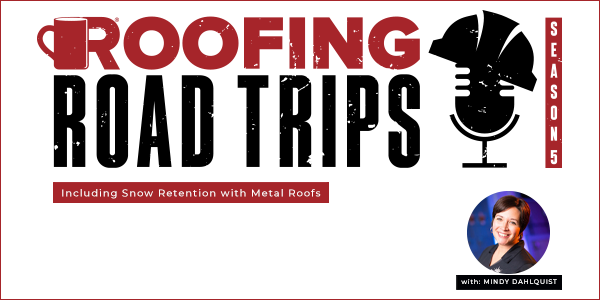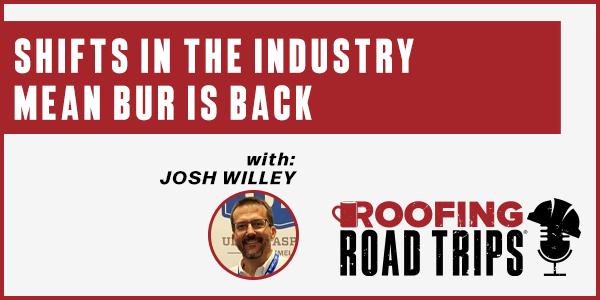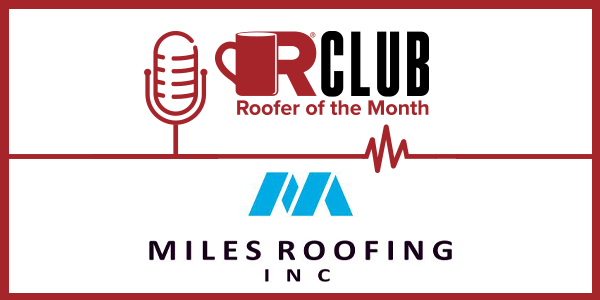Mindy Dahlquist - Snow Retention on All Roofing Types - PODCAST TRANSCRIPTION
May 1, 2023 at 8:00 a.m.Editor's note: The following is the transcript of a live interview with Mindy Dahlquist of TRA Snow and Sun. You can read the interview below or listen to the podcast.
Speaker 1: Welcome to Roofing Road Trips with Heidi. Explore the roofing industry through the eyes of a long-term professional within the trade. Listen for insights, interviews, and exciting news in the roofing industry today.
Heidi J. Ellsworth: Hello and welcome to another Roofing Road Trips from Roofer's Coffee Shop. My name is Heidi Ellsworth and we're here today to talk about something that is on everyone's mind this winter, and that is snow retention. Wow. Talk about a lot of snow in the mountains throughout the country. So I called up my dear friend Mindy Dahlquist, who is with TRA Snow and Sun, and said, "Hey, come talk to us about snow retention." So Mindy, welcome to the show.
Mindy Dahlquist: Thanks, Heidi. I am so excited to do this show.
Heidi J. Ellsworth: We are so excited to have you on Roofing Road Trips and talking about something that's really top of mind right now. I mean, I don't think it stops snowing in Oregon for the last four months and we aren't even close to what California is getting. So more than ever, this is such an important topic. Before we get started, if you could introduce yourself and tell us a little bit about TRA.
Mindy Dahlquist: Absolutely. Well, my name is Mindy Dahlquist and I am the business development manager at TRA Snow and Sun. I handle all of the education portions, the trade shows, all of those fun things. So usually you'll see me out and about doing all kinds of different things and traveling wherever I need to be. TRA, we do manufacturing of snow retention, and we do some roofing flashes, ridge risers, all kinds of different roofing accessories. So we are just in the roofing business to do whatever our customers need us to do.
Heidi J. Ellsworth: To make sure that the roof is safe.
Mindy Dahlquist: Absolutely.
Heidi J. Ellsworth: Well, tell us just a little bit about the history of TRA.
Mindy Dahlquist: Of course. So Terry Anderson did found TRA in 1996. He worked with some tile companies and was selling tile roofs throughout Utah and started to run into some concerns with snow moving on the roof. And so as he learned, as a roofing consultant, he was finding out that everyone was having issues with snow on the roof, not just with the tile. And so he traveled to Europe to try to find out exactly what they do with their snow and how they manage their snow, and found out that they do things a little bit differently than we do, and they don't really want their snow to shed off the roof. They use it as insulation on their roof and they want to retain it up there. So when he returned back to the United States, he designed and created snow brackets and then followed with snow fences, the manual for cold roof systems. Then some flexible flashing, all kinds of different things. And we've just really broke into the industry of roofing accessories and just holding snow on the roof and making sure that it's a safe environment.
Heidi J. Ellsworth: Fun fact, I worked with Terry way back in the day, way back in the day when I was working with EcoStar, I got to know Terry and talked about snow retention and how important it is, especially when you have roofs that are a little slicker than others. So why don't you share with us why snow retention is so important and what's really happened over the years?
Mindy Dahlquist: Of course. So safety is going to be the number one reason that snow retention is important. Oftentimes people will look at me like I'm crazy and say, "Why would I want to hold snow on the roof?" And it sounds like a sarcastic answer, but it's truly not that it does kill people every single year from that snow shedding off of the roof.
Unfortunately, when that snow is held on the roof, it's done so unintentionally very often. And so without snow retention, that snow holds on the roof in heavy snow load areas until then it just randomly slides off, and if you have dogs or children or you're out trying to fix your gutters or any reason for you to be outside, then it can become very, very dangerous.
It also can cause damage as it slides down the roof. So with concrete tiles or slate, synthetic roofing types, metal roofs, any of those types of roofs oftentimes do get damaged when that snow does slide. If you think of it like an ice cube tray, when you put something in the bottom of your ice cube tray and pop those ice cubes out, whatever is in the bottom there just comes out with it. And that's pretty much what happens to the roofing material as well.
Heidi J. Ellsworth: Wow. Yeah, and I mean, we're seeing the safety of people underneath the roof. And then also, like you said, I mean our neighbor had his whole chimney pulled off of his roof and I was just like, oh man. So we went over and said, "You need snow retention." A lot of times homeowners and building owners have no idea that that's even a thing. So as some of the contractors are out there starting to talk about different types of snow retention, maybe you could talk a little bit about the difference between brackets and fences.
Mindy Dahlquist: Absolutely. Brackets and fences are both designed differently and have different characteristics on how they work. So brackets are created to penetrate about three inches deep into the snow pack as that snow is falling and then creates more of a blanketed effect. So they are not designed to stop that snow once it's moving. So putting just a row of brackets along the eve is not going to be beneficial.
They are designed usually to go over the entirety of the roof in a staggered pattern. Your spacing and things would differ depending on the specific project, but what happens there is it holds that snow in place and allows it to freeze into one blanketed mass where a fence is completely different.
So a fence there are deck mount fences and clamp on fences. They're only different in the ways that clamp on fences are going to go onto the standing seam metal roofs where deck mount fences can go with any type of roofing application and they will go directly into structure. So with fences, the snow is going to slide into those fences and then just freeze in place. So it's more of a barrier instead of stopping it from moving ever. Oftentimes people will think that snow retention is made just to slice up that snow as it falls down or allow just little amounts to come down at the time, and that's not really the goal. The goal is just to hold it up there, create that insulating mass that's just going to be held safely in place until it can melt off when it's time, which this year we're not sure when that time will be.
Heidi J. Ellsworth: We don't know when that's going to be, but I can tell you having snow on the roof does provide insulation. We heat by wood and with that snow staying on the roof for us, it helps us throughout this winter not have to burn as much wood. Let's talk just a little bit too, because I mean you're talking about brackets and fences, and I wanted to make sure we mentioned in structure because you just said that versus clamps for metal. So that's also something that if you're doing metal roofing, they need to be thinking about, right?
Mindy Dahlquist: Absolutely. I mean, there's snow retention options for all different type of roofing materials, including asphalt shingles, which oftentimes is not an issue until we get these temperature swings like we're having right now in Utah where it is 70 degrees and sunny outside right now, but we still have massive amounts of snow. So that can be a concern for any roofing material. And so it's nice to have those different options for whatever type of application you need.
Heidi J. Ellsworth: Why should a contractor work with TRA instead of just doing it themselves?
Mindy Dahlquist: So working hand in hand with a contractor allows a lot of things. It allows the contractor to have just this back pocket of all of this information that they don't need to know off of the top of their head otherwise. So instead of just assuming where these brackets or fences should be placed, we're able to provide them with exact spacing information and then also a warranty as long as it's installed per that layout based solely on the information from their specific project. So we're not just saying, "Oh, this is what works best in Idaho." We're understanding exactly the placement of this project, where it's at, what roofing material, what the slope is, the ground snow load, all of those different factors. And then we also do testing on our own products.
So we have a lot of information that a roofing contractor would not have, like what the pullout strength of our fasteners are and what the actual strength of that individual snow retention device is. So we're able to provide a lot more stability and a lot more information to mitigate that risk completely from the customer and the roofing contractor as well.
Heidi J. Ellsworth: And I think that's so important because different parts of the country are going to have different parameters depending on, especially on altitude and everything else. I mean, let's talk a little bit about the difference between Pacific Northwest and the type of snow we get here, even on east and west side of the mountains compared to Utah or into Wisconsin.
Mindy Dahlquist: Yes. And I mean, the ground snow load alone is going to vary so much just within a 15-mile radius of you, depending on where you are. With me being in Utah, I mean there's elevations ranging in thousands all the way around us to where I am not going to receive the same amount of snow as somebody is in a cabin in the mountains. So we shouldn't be engineering our systems the same way based off of just a area code or a county or a state and those types of things. So we're able to provide a lot more information and make sure that it is ready to actually withstand that amount of weight.
Heidi J. Ellsworth: And you provide a warranty, and you will mitigate the risk. Talk a little bit about that.
Mindy Dahlquist: So just taking that liability off. I mean, as a contractor, if you are selling a specific type of roofing, whether it's synthetic, slate, metal, anything like that, or even asphalt shingles and something does happen and that snow does slide on the roof and causes damage or causes an injury, the last thing you want is the homeowner coming back to you and trying to blame you for this issue and saying, "Well, you know we lived in snow country. You knew this information." And so this just gives you the ability to have that risk taken away completely.
So if you are to install snow retention and damage does occur, then we're able to replace that snow retention for you and we're able to say, listen, that was our problem. It doesn't happen very often and it usually just comes down to a very small issue, but that is something that you don't want to be part of. You want to be able to pass that off to someone else, so leaving it to the people that do have the information on all of the background of the products and exactly how the system is engineered is the best way to figure that out and make sure that the homeowner in the home or project, whatever it is, safe and secure at the end of the day.
Heidi J. Ellsworth: Yeah, I think that is so important as a contractor, when you're sitting there talking to owners, there's a definite risk factor of not doing snow retention, which can be legal lawsuits, not to mention how unsafe it is. So as a contractor is meeting with their owners, how do you recommend that they really talk to their owners about snow retention to really be able to get them, because there is a little bit of extra cost, but it's saving lives. How do they have that discussion?
Mindy Dahlquist: So I think the most important thing is getting in front of it before it's an issue and having those conversations. I'm always happy to help provide video information or educational information on exactly why snow retention would be necessary in specific situations. There's all types of videos out there of fails of snow falling off the roof or fails of people trying to shovel snow off of the roof, and that is something that causes deaths every year as well to where there's a lot of safety factors that can go in there for the roofer to have that conversation. But then there's also a lot of more surface types of situations considering your roofing material itself, wanting to make sure that that is maintained in a good manner. Because all you need is one good slide of snow on that roof, and it can tear parts of your roof away that you won't even know are gone until you have a water problem.
And so if you have snow just sitting in the valley or sitting in there and then it decides to slide, you're going to cause some type of issue. It also can slide off and take your gutters with it. It can take your deck out. It can take all kinds of other types of situations that can happen that just go to show to the homeowner that this is important because this is part of your asset. This home is important to you, your safety's important to you, and no one wants to pull their nice car out of their garage and have a thousand pounds of snow slide on it.
So it becomes, once you start having those conversations, a lot of people think that snow and ice is light and fluffy and it's just going to fall off there and it's not going to be a big deal. But once you get into snow loads and really start to think about it, a good way to talk about it is this way.
I mean, a 50 pound snow load area is not a lot of snow. I mean, most of the mountain regions and ski resorts are getting 200 to 400 pounds per square foot. So a 50 pound snow load area is kind of looked at as, oh, this is no big deal. But when you look at a four-foot section that's 15 feet long of a 50 pound snow load area, suddenly that's 3000 pounds. And so if that falls on your windshield or anything like that, I mean, that's the size of a Honda Civic, I'm pretty sure. So at that point it becomes a little bit more of a big deal and kind of puts into a perspective of a homeowner that I don't want this roof to shed the snow anywhere that it could cause damage or fall on my neighbor's solar panels or any of those situations that are just not ideal.
Heidi J. Ellsworth: And we didn't even talk about landscaping. I mean, I know that's nothing compared to the worry of little children or people or animals, but without the right snow retention, you can have mounds of snow around your house through this year, probably July, and it just kills all the landscaping around the house.
Mindy Dahlquist: Yep. Everyone's grass underneath there or trees underneath there are currently struggling to get out, and it's just not going to happen.
Heidi J. Ellsworth: It's not going to happen. I see it around our place. There's some big berms out there of snow right now. Well, as you were talking to contracting companies and talking to their sales teams and obviously their operations, and when you are really looking at all the different types of roofing that are out there, what are some of the tips that you offer, that you talk to them about with snow retention and the different types of roofing products?
Mindy Dahlquist: So I think it really just comes down from project to project. It's going to be very specific depending on what you have going on. If you're building a gorgeous, secluded cabin, your snow retention and your roofing product is probably going to be different than if you're building a large trucking shop or something like that. So I think it's very important to consider the type of project, the type of aesthetic that you're going for that project. And then we're always willing to talk to you about what is going to be best and what's going to be in your best interest as far as brackets or fences.
I mean, there's going to be a cost difference, but it really is just going to depend on that project because I can't say that one is more expensive than the other because in different situations, more is needed of one than the other and vice versa. So it really just comes down to using your resources for your snow retention manufacturer and relying on them, leaning on them to learn a little bit more and finding out exactly what you're working with.
If you're working with slate, then your options are going to be more like a bracket or a deck mount fence where if you're working with standing seam metal, your best option is usually going to be a clamp on system. If you have exposed fastener metal, you're going to probably go with a deck mount system. So it really just comes down to which specific type of roofing material you're using, what the placement of the project is, and how we can help you guide through the process.
Heidi J. Ellsworth: How do contractors get ahold of you to start that referral or that informational educational process?
Mindy Dahlquist: Absolutely. I mean, you can always call us. That is perfectly fine to call us directly at TRA or you can email us. That is going to be the best way to handle any kind of layout information, things like that. With that, you'll just email sales@trasnowandsun.com, and then you can also reach us in any of the YouTube, Facebook, LinkedIn, all of the crazy amounts of social media that we all have nowadays. And we're more than happy to jump at any assistance or any questions that you may have.
Heidi J. Ellsworth: And I will say TRA is on both Metal Coffee Shop and Roofer's Coffee Shop full directory. So if you're driving and listening to this, you can get all the information there to find Mindy and her team of amazing customer service reps at TRA, and whether it's you're ready to have them help you engineer a roof, or you just want to learn about it so that you can sell better when you go see your homeowners, I think there's going to be a lot of questions about it this summer, and this is the time to kind of get your team up to speed with the importance of snow retention and where. Because, like Mindy says, it differs all over the country, but there's been a lot of snow all over the country too.
Mindy Dahlquist: Yes, there has. And I think a good thing that I always consider is even if snow retention isn't the right thing for you currently, it's always a good thing to see what it might look like. So if you wanted a sample of what a snow retention layout looks like, I can always send you one that we've done previously so that you're able to see, okay, in this situation, this is what occurred, and this is what it would look like.
Heidi J. Ellsworth: And that's important too, just getting the education ahead of time so that when it's the middle of the summer and you're trying to get those roofs on before the snow flies again, you aren't waiting. You know who to talk to, and you know what it's going to be all about.
Mindy Dahlquist: Absolutely.
Heidi J. Ellsworth: Yeah. Well, Mindy, thank you. Thank you so much. Great information. So timely. One more time, again, if people want to get ahold of you, what was the email that they should email?
Mindy Dahlquist: It is sales@trasnowandsun.com. And then our office phone number is (801) 756-8666.
Heidi J. Ellsworth: Perfect. Okay. And you can find all of this on Roofer's Coffee Shop in the directory or in Metal Coffee Shop in the directory there for TRA Snow and Sun. I really encourage you all to take the time now before you get into the heart of the season to be able to add this kind of protection to your offerings. Mindy, thank you so much for all your information and for being on Roofing Road Trips.
Mindy Dahlquist: Of course. Thank you so much. I definitely looked forward to it, and I'm excited to see you again soon.
Heidi J. Ellsworth: We will. We've got all kinds of shows coming. It's going to be a busy summer.
Mindy Dahlquist: All right. Thanks, Heidi.
Heidi J. Ellsworth: I love it. Thank you. And thank all of you for listening. It's this kind of information that we want to bring to help your business every single day. So be sure to get onto Roofer's Coffee Shop, check out all of our Roofing Road Trips under the RLW Podcast or on your favorite podcast channel. Be sure to subscribe and hit those notifications so you don't miss a single episode. We'll be seeing you next time on Roofing Road Trips.
Speaker 1: Make sure to subscribe to our channel and leave a review. Thanks for listening. This has been Roofing Road Trips with Heidi from the rooferscoffeeshop.com.























Comments
Leave a Reply
Have an account? Login to leave a comment!
Sign In